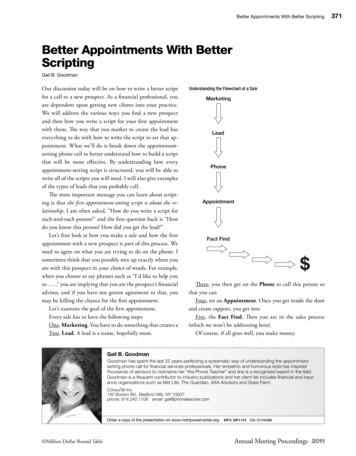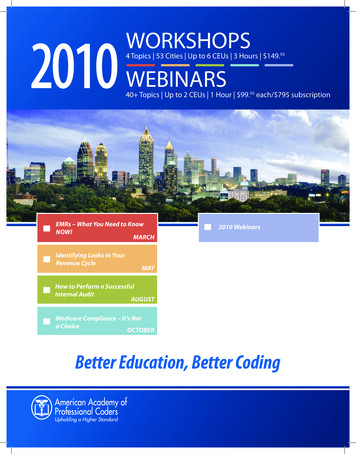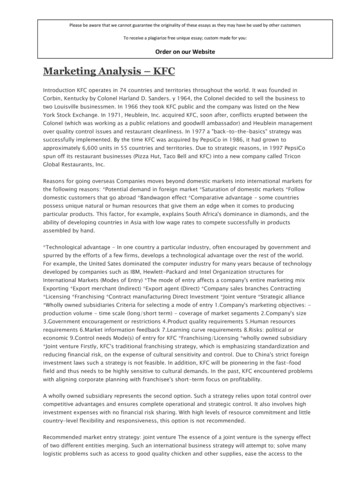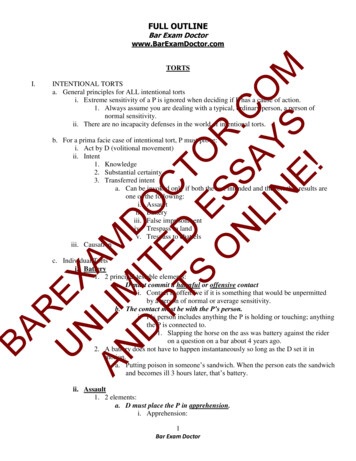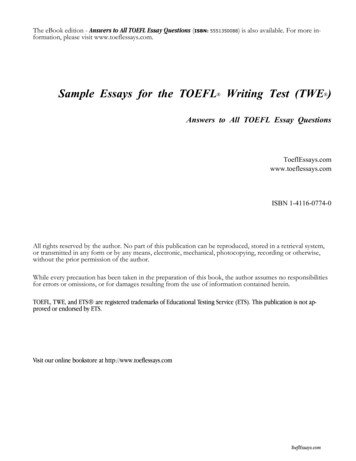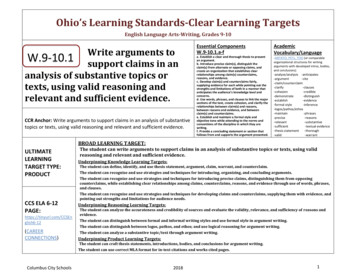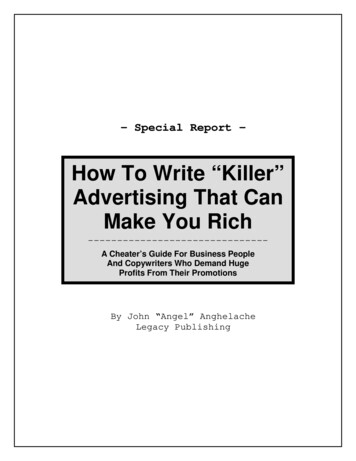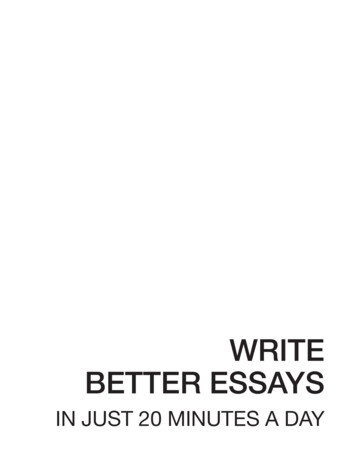
Transcription
WRITEBETTER ESSAYSIN JUST 20 MINUTES A DAY
WRITEBETTERESSAYSIN JUST 20MINUTES A DAY2nd Edition NEWYORK
Copyright 2006 LearningExpress, LLC.All rights reserved under International and Pan-American Copyright Conventions.Published in the United States by LearningExpress, LLC, New York.Library of Congress Cataloging-in-Publication Data:Write better essays in just 20 minutes a day—2nd ed.p. cm.Rev. ed. of: Write better essays in just 20 minutes a day / Elizabeth Chesla. 1st ed. 2000.ISBN 1-57685-546-51. English language—Rhetoric—Problems, exercises, etc. 2. Essays—Authorship—Problems, exercises, etc. 3. Report writing—Problems, exercises, etc. I. Chesla,Elizabeth L. Write better essays in just 20 minutes a day. II. LearningExpress(Organization) III. Title: Write better essays in just twenty minutes a day.PE1471.C47 2006808.4—dc222006000438Printed in the United States of America9 8 7 6 5 4 3 2 1Second EditionFor information or to place an order, contact LearningExpress at:55 Broadway8th FloorNew York, NY 10006Or visit us at:www.learnatest.com
ContentsINTRODUCTION1PRETEST7SECTION 1Planning the Essay17LESSON 1Thinking about Audience and Purpose19LESSON 2Understanding the Assigned Topic25LESSON 3Brainstorming Techniques: Freewriting and Listing31LESSON 4More Brainstorming Techniques: The 5 W’s and Mapping37LESSON 5Choosing a Topic and Developing a Thesis43LESSON 6Outlining and Organizational Strategies49LESSON 7More Organizational Strategies57SECTION 2Drafting the Essay63LESSON 8Thesis Statements and the Drafting Process65LESSON 9Paragraphs and Topic Sentences71LESSON 10Providing Support77LESSON 11Strategies for Convincing85v
– CONTENTS–LESSON 12Introductions93LESSON 13Conclusions99SECTION 3Revising, Editing, and Proofreading the Essay105LESSON 14Revising: The Big Picture107LESSON 15Revising Paragraphs113LESSON 16Editing121LESSON 17Proofreading131SECTION 4Taking an Essay Exam141LESSON 18Preparing for an Essay Exam143LESSON 19Drafting, Editing, and Proofreading151LESSON 20Sample Essay Exam Questions and Answers157POSTTEST163ANSWER KEY173ADDITIONAL RESOURCES193vi
IntroductionYou probably can’t even count how many essays you’ve written for your high school classes. There areessays assigned in English and composition classes, history and civics classes, and language classes.Many electives even require essays. If you’re a junior or senior, you know that the stakes for essay writing keep getting higher. You’ll probably have to write one in class as part of an exam, and/or have a large part ofyour grade based on an essay. But they’re not just worth grades—essays are also a part of high-stakes tests like theACT, Regents’, and SAT; and they’re required on college applications.How can you improve your essay-writing skills, not only to get better grades, but also to score higher on testsand boost your chance for admission to the college you’d like to attend? This book offers a step-by-step plan thatcan be completed in just a few weeks. How to Use This BookThere are 20 lessons in this book, each of which should take you about 20 minutes to complete. If you read fivechapters a week and complete the practice exercises carefully, you should become a more powerful and effectiveessay writer in one month.Although each lesson is designed to be an effective skill builder on its own, it is important that you proceedthrough the book in order, from Lesson 1 through Lesson 20. The material in Section 2 references and builds onwhat you’ll learn in Section 1, as Sections 3 and 4 reference and build on Sections 1 and 2. Writing is a process—a series of skills, strategies, and approaches that writers use to create effective essays. In reality, this process isn’tas linear this book presents. You might prefer to brainstorm first, and then write a thesis statement—and that’sfine. However, once you understand the writing process, you can adapt it to your unique working style and to eachspecific writing situation you encounter.1
– INTRODUCTION–The first section of the book, Planning the Essay, covers the basic prewriting steps that are essential to effective writing. Drafting the Essay, Section 2, shows you how to take your ideas and formulate a solid working draft.In the third section, Revising, Editing, and Proofreading the Essay, you’ll learn how to shape your draft into a clear,effective essay. Taking an Essay Exam, the fourth section, provides strategies for writing under the pressure of aticking clock, whether for an in-class exam or a test such as the ACT or SAT.Each lesson includes several practice exercises that allow you to work on the skills presented in that lesson.The exercises aren’t simply matching or multiple-choice questions. Instead, you’ll practice what you’ve learned bydoing your own writing. These practice exercises are central to your success with this book. No matter now manyexamples you see, you really won’t benefit fully from the lessons unless you complete the exercises. Remember tokeep your practice answers as you work through the book—some lessons will ask you to further develop ideas generated in earlier practice exercises.To help you stay on track, use the sample answers and explanations for the practice exercises at the back ofthe book. Check them at the end of each lesson, reading the explanations carefully as you review your responseto the exercise. Keep in mind that there is no single correct answer to most exercises. What you’ll find instead aresuggested answers that contain all the elements called for in the exercise.You’ll also find practical skill-building ideas at the end of each lesson—simple thinking or writing tasks youcan do to sharpen the skills you learned in that lesson. Some of these exercises ask you to read an essay and examine it for a specific element or detail. You can find essays in many places, such as an English or composition classtextbook, or on the Internet. If you have trouble finding appropriate writing, check the list of suggested readingin the Additional Resources section at the end of the book.To gauge your progress, we’ll begin with a writing pretest. You should take the test before you start Lesson1. Then, after you’ve finished Lesson 20, take the posttest. The tests are different but comparable, so you’ll be ableto see just how much your understanding of the writing process and your writing skills have improved. Different Types of EssaysWhat makes writing both interesting and challenging is that every writing task is unique. Writing is communication: You are expressing ideas about a subject to an audience for a purpose. Each time you sit down to write, oneor more of these three elements will be different, creating a unique writing situation.Essays are one of many different forms, or genres, of writing. While there are many different kinds of essays,general skills and strategies apply to all of them. This book will teach you those skills and strategies and help youpractice them. Specifically, we’ll help you apply those skills and strategies to three essay types: The college application essayEssays for high school and college classes (timed and untimed)The standardized, timed essay exam (such as ACT, GED, Regents’, SAT)Section 4 of this book (Lessons 18, 19, and 20) extensively covers the standardized, timed essay exams. Here is moreinformation about how to approach and successfully complete application and class assignment essays.2
– INTRODUCTION–The College Application EssayMost colleges and universities require students to submit a written essay with their application. The nearly 300schools that use the Common Application (www.commonapp.org) present five topics from which you must selectand write on one. Other schools use similar types of topics, or even ask you to come up with your own.No matter the topic, though, the purpose of this essay remains the same: to reveal something personal aboutyou that will give the admissions department a better idea of who you are and why they should accept you. Thisisn’t the time to wow your reader with your insights into current social problems or the poetry of the seventeenthcentury. Your audience, an admissions officer, want to learn about you. A successful college application essay transforms you from a two-dimensional applicant into a dynamic, three-dimensional “real” person. And in most cases,the more real you are to the admissions officer, the more likely it is that he or she will accept you.Of course, the application essay also gives the reader a sense of how well you can communicate in writing,and that ability is crucial to your academic success. After all, admissions officers are not only looking to see if you’rea good fit for the university—they also want to see that you’ll be able to handle their curriculum and that you canread and write effectively at the college level.Here are some Common Application topics and writing requirements found on most other applications:1. Evaluate a significant experience, achievement, risk you have taken, or ethical dilemma you have faced, and itsimpact on you.2. Discuss some issue of personal, local, national, or international concern and its importance to you.3. Indicate a person who has had a significant influence on you and describe that influence.4. Describe a character in fiction, an historical figure, or a creative work (as in art, music, science, etc.) that hashad an influence on you.5. A range of academic interests, personal perspectives, and life experiences adds much to the educational mix.Given your personal background, describe an experience that illustrates what you would bring to the diversityin a college community, or an encounter that demonstrated the importance of diversity to you.6. Topic of your choice.7. Submit a writing sample.“Topic of your choice” and “submit a writing sample” allow you to recycle something you’ve written for a class,or even another application (just be sure to change or delete any references to another school).No matter which topic you select, remember that it is meant simply as a vehicle for revealing something aboutyou, not the historical figure, issue of international importance, or person who has influenced you. But being personal can be tricky. Anything and everything in your life or about your personality is not appropriate admissionsessay material. College admissions officers note that the worst essays are depressing and/or paint an unflatteringpicture of the applicant. Think of it this way: Your job in the essay is to get the reader to like you. Don’t hand himor her a reason to reject you by revealing negative information. Your goal is to sound competent and responsible.3
Tips for SuccessHere are a few other specific strategies to help you write a winning college application essay: Avoid clichés. The typical admissions officer reads hundreds of essays each winter. You won’t stand out,and you’ll run the risk of boring him or her, if you write about a subject also chosen by dozens of other students. What’s been done too many times before? Here are a few subjects virtually guaranteed to bore youraudience: how you’ve been influenced by a famous person, the death of a grandparent, losing the big game,why you want peace in the Middle East, etc.Think local, not global. The small, uniquely personal experience is more revealing than your response to 9/11or your plan to solve global warming. “Local,” or small, also guarantees that your essay will be original.Choose a subject that you alone have found significance in, and you’ll have a better chance of writing thekind of essay they’re looking for.Don’t brag or overstate your importance. There is a fine line between appropriately advocating for yourselfand your talents, and sounding like a walking ego. In general, don’t take credit for anything you shouldn’t(did your team really win the championship because of your leadership skills?).Avoid offensive topics. You don’t know if your essay will be read by a 20-something, a 70-something, Democrat or Republican, male or female, gay or straight, white or black, Christian or Buddhist. Therefore, the riskof offending this unknown reader is great. You should steer clear of touchy subjects, and be careful not todismiss or critique the other side of your argument while laying out your own.Essays for High School and College ClassesIn almost every high school or college class, you can expect at least part, if not all, of your evaluation for the termto be based on your written work. In a college literature class, for example, 100% of your grade will probably bebased on two out-of-class essays, an in-class midterm, and a final essay, which may be a timed exam. In a political science class, your midterm and final exams might include multiple-choice, short answer, and essay questions.Your success in school depends heavily on your ability to write effectively, both in and out of the classroom.Types of Essay AssignmentsEssay assignments in high school and college classes will be as varied as the instructors who teach them. Mostassignments, however, will fall into one of two categories:1. The Personal EssayIn composition classes and in college placement exams, you will often be asked to write an essay based on apersonal experience or observation. Here are two examples:Alison Lurie wrote, “Long before I am near enough to talk to you in the street or at a party, you announce yourpersonality and opinions to me through what you are wearing. By the time we meet and converse, we havealready spoken to each other in an older and more universal language: the language of clothing.” Write an essayin which you agree or disagree with this statement. Use evidence from your personal experience, observations,or reading to support your position.4
Tips for SuccessHere are some strategies for successful high school and college essays: Fulfill the assignment. Have a clear thesis that directly responds to the assignment, and develop it as required.Provide solid support. Whether you’re writing a personal essay or an analysis essay, you need to show readers that your thesis is valid. Support your ideas with specific examples, evidence, and details.Be correct. You need to convey your ideas clearly. Make sure your sentences are clear and free of errors ingrammar and mechanics.Write with style. Most of your essays will be on the formal side, but that doesn’t mean they have to be dulland dry. Choose interesting words that state exactly what you mean, including vivid verbs and specific adjectives and adverbs.Describe a time when you presented yourself as believing in something you really did not believe in. Why didyou present yourself that way? What were the consequences, if any, of this misrepresentation? How would youpresent yourself in a similar situation today? Explain.2. The Analysis EssayIn most other classes, essay assignments will often ask you to analyze specific texts, ideas, events, or issues.Here are three examples from different disciplines:From a religious point of view, what is truth? Use examples from two different religions to support your answer.Analyze a local television news program. What stories and events get coverage? How are these stories and eventscovered? What values and beliefs about America, about the world, and about television and its viewers do youthink the news program’s coverage reflects?What illusions does Renoir’s film La Grande Illusion refer to? Discuss those illusions and how the historicevents that led to World War I helped foster them.5
PretestBefore you begin this book, it’s a good idea to find out how much you already know and how muchyou need to learn about the essay-writing process. This test is designed to help you do that. It consists of two parts. Part 1 contains 20 multiple-choice questions addressing several key componentsin this book. Part 2 asks you to write your own essay and evaluate it according to the criteria provided.You can use the space on the pages following Part 2 to record your answers and write your essay. Or, if youprefer, simply circle the answers directly for Part 1. Obviously, if this book doesn’t belong to you, use separate sheetsof lined paper to write your responses.Take as much time as you need for Part 1 (although 20 minutes is an average completion time). When you’refinished, check your answers against the answer key at the end of this book. Each answer tells you which lessondeals with the concept addressed in that question. Set aside another 30 minutes to complete Part 2.7
– LEARNINGEXPRESS ANSWER .17.18.19.20.aaaaaabbbbbbcdcdeccddee
– PRETEST – Part 11. All essays should be about five or six paragraphs long.a. trueb. false2. The best place in an essay for the thesis statement is generallya. the first sentence in an essay.b. the last sentence in an essay.c. the end of the introduction.d. in the third paragraph.3. A good introduction should do which of the following?a. grab the reader’s attentionb. state the thesisc. provide the main supporting ideas for the thesisd. both a and be. all of the above4. Your relationship with your readers has an effect on how you write your essay.a. trueb. false5. Which of the following best describes the problem with the following paragraph?Sullivan studied 25 city playgrounds. He found several serious problems. The playgrounds were dirty. Theywere also overcrowded. They were also dangerous. Many parks had broken glass everywhere. Many parks alsohad broken equipment.a. lack of variety in sentence structureb. grammatical errorsc. lack of transitionsd. poor word choice6. Which organizational strategy does the paragraph in question 5 use?a. compare and contrastb. chronologyc. problem solutiond. order of importance11
– PRETEST –7. Read the following essay assignment carefully.Some say “ignorance is bliss.” Others claim that ignorance is a form of slavery and that only knowledge can setyou free. With which view do you agree? Explain your answer.Determine which sentence below best describes the kind of essay you should write.a. Explain the difference between “ignorance” and “knowledge.”b. Explain which belief you concur with and why.c. Explain how you think we can improve education.d. Discuss the evils of slavery.8. Which of the following organizational patterns applies to all essays?a. order of importanceb. cause and effectc. assertion supportd. problem solution9. A thesis is best defined asa. the prompt for an essay.b. the main idea of an essay.c. an essay that is at least three pages long.d. the way a writer introduces an essay.10. In the following paragraph, the first sentence is best described as which of the following?More and more Americans are turning to alternative medicine. The ancient art of aromatherapy has gained atremendous following, particularly on the West Coast. Acupuncture, the traditional Chinese art of “needle therapy,” has doubled its number of active practitioners in the past decade. And holistic medicine—treating thewhole body instead of just one part—is so popular that some HMOs now even pay for holistic care.a. a transition sentenceb. a topic sentencec. a supporting idead. a thesis11. In the paragraph in question 10, the second sentence is best described as which of the following?a. a transition sentenceb. a topic sentencec. a supporting idead. a thesis12. Which of the following should a conclusion NOT do?a. Bring in a new idea.b. Restate the thesis in fresh words.c. Provide a sense of closure.d. Focus on the reader’s emotions.12
– PRETEST –13. Words and phrases like meanwhile, on the other hand, and for example are known asa. passive words.b. assertions.c. modifiers.d. transitions.14. Which of the following strategies is particularly useful during an essay exam?a. brainstormingb. freewritingc. outliningd. journaling15. Brainstorming typically takes place during which step in the writing process?a. planningb. draftingc. proofreadingd. revising16. Revising and proofreading are interchangeable terms.a. trueb. false17. Support for a thesis can come in which of the following forms?a. specific examplesb. expert opinionc. anecdotesd. both a and be. a, b, and c18. Never use a one-sentence paragraph.a. trueb. false19. What is the main problem with the following sentence?Newman lost the election because of the fact that the opponent whom he ran against had a lot more moneyfor ads.a. It’s a run-on sentence.b. It’s not properly punctuated.c. It’s unnecessarily wordy.d. It lacks parallel structure.e. There is no problem with this sentence.13
– PRETEST –20. Which of the following strategies will make an essay more convincing?a. avoiding run-on sentencesb. acknowledging counterargumentsc. providing specific examples and detailsd. both b and ce. both a and c Part 2Set a timer for 30 minutes. When you’re ready to begin, carefully read the following essay assignment. Use the spaceprovided to write your essay. Stop writing when 20 minutes have elapsed, even if you haven’t completed your essay.When you’re finished, look at the scoring chart in the answer key to estimate your essay’s score.Essay AssignmentMany people have been profoundly affected by great works of art. Describe a work of art—a book, a movie, a photograph, a drawing, a painting, a song, or a musical composition—that had a powerful impact on your life. Whatwork of art was it? How did it affect you? Why?14
– PRETEST –15
– PRETEST –16
S E C T I O N1Planningthe EssayWhile creativity and inspiration can play an important role in goodessay writing, planning, drafting, and revision are critical. Whetheryou have to write an essay in class, during a test, or at home, gettingdown to the business of writing means focusing on these three things. In this section, you’lllearn planning strategies that will not only improve the effectiveness and quality of yourwriting, but will also help eliminate many of the frustrations writers face. In addition, they’llbenefit your reader by showing him or her how the various points you make in your essaywork together and how they support your thesis.When you begin your essay with planning, you will have guidance and directionthrough the writing process, especially if you are in a timed situation. Planning lets yousee how your many developing ideas fit within a framework, and clearly maps out any typeof essay you are required to write.17
L E S S O N1Thinking aboutAudience andPurposeLESSON SUMMARYThe first step toward effective essay writing is to know why and forwhom you’re writing. This lesson explains how to understand youraudience and purpose and how these two factors affect your writing.Imagine you’ve just had an amazing experience: You were able to save someone’s life by performing CPR.You want to share the experience with three people: your father, your best friend, and the admissions officer at your first-choice college. How will you describe what happened? Will that description be the samefor each person? Probably not. Although the subject remains a constant, each person is a different audience, requiring different word choices, levels of formality, and tone.Because you are sharing the experience with these three people for different reasons, the purpose of yourdescription changes, too. You might tell your father to let him know that his advice about taking a CPR coursewas invaluable. To your friend, you might stress the emotions the experience evoked. In your college applicationessay, you place an emphasis on the experience’s revelation of your competent and responsible nature.Audience and purpose not only determine how you write; they shape your content, or what you write as well.Therefore, the first step to writing better essays is to understand who you are writing for and why you are writing.19
– THINKING ABOUT AUDIENCE AND PURPOSE– Understanding Your AudienceImagine that you’ve been asked to write about your life-saving experience for the local hospital newsletter. Youexpect your audience to be adults, so you plan and draft your article in anticipation of that audience. But whenyou submit it, you find that the hospital plans to use your article in a supplement for elementary school students.Can they print it as written? Not if they want their readers to understand what you’ve written.Understanding your audience is a critical component of effective writing. Before you begin any type of essay,you must find out:1. Who will read your essay and why are they reading it?2. What do they know about your subject?3. What is your relationship with the reader?Pinpointing Your AudienceIf you’re writing for a teacher, you know his or her name and face, as well as the expectations he or she has for yourwriting. But determining your audience doesn’t always mean knowing exactly who will be reading, grading, orscoring your essay. In fact, often you’ll need to write for someone, or a number of people, you’ll never meet. Forexample, if you are taking the ACT or SAT, you know that two people will read your essay and score it. You alsoknow the criteria for each score. You don’t know the readers’ names, or where they’re from, but you knowenough about what they’re looking for to understand how to write to them. Knowing your audience in this casemeans knowing what they’re looking for.In other words, your readers will pick up your writing in order to give it a grade or score. You need to knowtheir expectations in order to fulfill them. What does your English teacher consider an A essay? How does a college admissions officer judge an essay? For the SAT and ACT, what does the scoring rubric look like? What are thedifferences between an essay that gets a 6, and one that gets a 2? Here are some general guidelines:WHO THEY AREWHAT THEY’RE LOOKING FORAdmissions officeran engaging essay that reveals your personality, goals, and values; evidence thatyou can organize your thoughts and communicate effectivelySAT and ACT scorersa polished rough draft that responds to the topic, develops a point of view, and supports that point of view with examples and evidenceAP Exam evaluatorsa clear and cohesive essay that demonstrates mastery of the subject matterHigh school teachersa combination of the following: mastery of the material (do you understand thebook, concept, issue?); a clear and original thesis; mastery of the essay form (clearthesis, strong support, logical organization); mastery of standard written EnglishHere’s an example. Imagine that you have been asked to write about a poem. Clearly, you could not writethe same essay for a college application and an English Literature AP exam. You have two different sets of actualreaders who want two very different things from you.20
– THINKING ABOUT AUDIENCE AND PURPOSE–Admissions officers, for example, would prefer a very personal response to the poem, one that revealssomething about who you are and what is important to you. They might want to know if the poem helps you better understand something about yourself and your values. They might want to know how you understand the poem.What does it mean to you? How does it make you feel? What do you get out of it? How can you relate it to your life?The Audience’s Relationship to the SubjectIn addition, it’s essential to consider the relationship of your audience to your subject. What are they likely to knowabout your topic? How interested will they be in what you have to say? How likely are they to agree or disagreewith your ideas?What Your Readers Know about the SubjectOne of the biggest mistakes writers make is to assume that their readers know what they’re talking about. Justbecause you know your subject intimately doesn’t mean your readers do. You need to carefully consider how muchyour readers may know about your subject. For example, you’ve decided to write about your interest in roboticsfor your college application essay. If you use terms like “range weighted Hough Transform” and “sensor fusion algorithm,” chances are your readers won’t know what you’re talking about. You’ll either have to explain your termsor replace the technical jargon with words the average reader can understand.Similarly, say you decide to write about your favorite novel. Should you assume your readers have read thenovel? If they have, should you assume that they read it recently enough to remember its characters, plot, andthemes? Unless you know for sure, or unless your assignment specifically mentions an assumption (“assume yourreaders have read The Great Gatsby carefully”), you must provide sufficient background information for your readers. You’ll need to briefly summarize the plot and provide context for the specific scenes and issues you’d like todiscuss.How Your Readers Feel about the SubjectAnother important consideration is how your readers might feel about the subject. Will they be interested in it?If not, what can you do to arouse their interest? If you’ve taken a position on an issue, how likely is it that yourreaders will share your opinion? If they’re likely to disagree, how can you help them accept, or at least understand,your position? (You’ll learn more about this issue in Lesson 11.)Your Relationship to the ReaderFinally, there’s one more question to ask about your audience: What is your relationship to him or her? This relationship helps determine the style, tone, and format of your essay.Though the writing situations discussed in this book are different, your relationship to the actual reader isquite similar in each case: that of evaluatee to evaluator. The primary reason your actual readers—college admission officers, SAT and ACT scorers, AP essay exam readers, and teachers—are reading your essay is not for theirreading pleasure. Instead, they are reading to evaluate.How does this relationship affect your writing? For most situations, it is in your best interest to be formal(but not stuffy), respectful (but not overly gracious), and courteous (but not cerem
Elizabeth L. Write better essays in j ust 20 minutes a day. II. LearningExpress (Organization) III. Title: Write better essays in just twenty minutes a day. PE1471.C47 2006 808.4—dc22 2006000438 Printed in the United States of America 987654321 Second Edition For information or to place an
